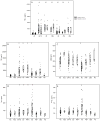Cerebrospinal fluid neurofilament concentration reflects disease severity in frontotemporal degeneration
- PMID: 24242746
- PMCID: PMC4020786
- DOI: 10.1002/ana.24052
Cerebrospinal fluid neurofilament concentration reflects disease severity in frontotemporal degeneration
Abstract
Objective: Cerebrospinal fluid (CSF) neurofilament light chain (NfL) concentration is elevated in neurological disorders, including frontotemporal degeneration (FTD). We investigated the clinical correlates of elevated CSF NfL levels in FTD.
Methods: CSF NfL, amyloid-β1-42 (Aβ42), tau, and phosphorylated tau concentrations were compared in 47 normal controls (NC), 8 asymptomatic gene carriers (NC2) of FTD-causing mutations, and 79 FTD (45 behavioral variant frontotemporal dementia [bvFTD], 18 progressive nonfluent aphasia [PNFA], 16 semantic dementia [SD]), 22 progressive supranuclear palsy, 50 Alzheimer disease, 6 Parkinson disease, and 17 corticobasal syndrome patients. Correlations between CSF analyte levels were performed with neuropsychological measures and the Clinical Dementia Rating scale sum of boxes (CDRsb). Voxel-based morphometry of structural magnetic resonance images determined the relationship between brain volume and CSF NfL.
Results: Mean CSF NfL concentrations were higher in bvFTD, SD, and PNFA than other groups. NfL in NC2 was similar to NC. CSF NfL, but not other CSF measures, correlated with CDRsb and neuropsychological measures in FTD, but not in other diagnostic groups. Analyses in 2 independent FTD cohorts and a group of autopsy-verified or biomarker-enriched cases confirmed the larger group analysis. In FTD, gray and white matter volume negatively correlated with CSF NfL concentration, such that individuals with the highest NfL levels exhibited the most atrophy.
Interpretation: CSF NfL is elevated in symptomatic FTD and correlates with disease severity. This measurement may be a useful surrogate endpoint of disease severity in FTD clinical trials. Longitudinal studies of CSF NfL in FTD are warranted.
© 2014 Child Neurology Society/American Neurological Association.
Figures



References
-
- Neary D, Snowden JS, Gustafson L, et al. Frontotemporal lobar degeneration - A consensus on clinical diagnostic criteria. Neurology. 1998;51:1546–1554. - PubMed
-
- Blennow K, Zetterberg H, Rinne JO, et al. Effect of immunotherapy with bapineuzumab on cerebrospinal fluid biomarker levels in patients with mild to moderate Alzheimer disease. Archives of Neurology. 2012;69:1002–1010. - PubMed
-
- Green AJE, Harvey RJ, Thompson EJ, Rossor MN. Increased tau in the cerebrospinal fluid of patients with frontotemporal dementia Alzheimer’s disease. Neuroscience Letters. 1999;259:133–135. - PubMed
Publication types
MeSH terms
Substances
Grants and funding
LinkOut - more resources
Full Text Sources
Other Literature Sources
Medical

